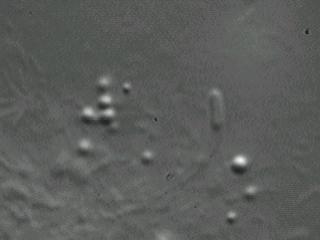
Movie Gallery |
|
| Listeria monocytogenes in COS7 cells -- falling off its tail | |
 Click
to load QuickTime movie, 683Kb Click
to load QuickTime movie, 683Kb |
|
Listeria monocytogenes is a rod-shaped pathogenic bacterium that invades the cytoplasm of living cells. Inside cells, it recruits various host factors that are required for host cell motility, but Listeria use these factors for its own motility. A distinctive rocket tail structure which is highly crosslinked F-actin develops to push Listeria through the cytoplasm. Eventually, these "rockets" push bacteria into neighboring cells, propagating the infection. Because it recruits only a limited number of host factors for this motility, Listeria is an excellent system to study mechanisms of host cell motility. Using high-resolution laser-tracking of Listeria motility, we have disproven popular models suggesting mechanisms for how F-actin rocket propels bacteria. This movie shows how Listeria is attached to its tail during active motility, but even before the tail depolymerizes, the bacterium exhibit "fish-tailing" wobbling motion. Such wobbling is characteristic of bacteria outside cell. Since original models likened its motility to surfing, we call this movie clip "WipeOut". |
|
| Shigella flexneri inside living COS7 cells | |
These are movies of Shigella
flexneri inside
living COS7 cells, monitored in real-time (10s between
images).
|
|
|
|
|
|
|